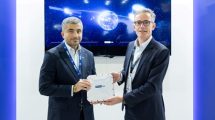 A new Crew Interactive MObile CompanioN (CIMON) for the International Space Station (ISS) dubbed CIMON-2 lifted off on its journey into space on December 5, 2019. This modified version of the astronaut assistant has been equipped for new tasks and was developed and built in Germany.
A new Crew Interactive MObile CompanioN (CIMON) for the International Space Station (ISS) dubbed CIMON-2 lifted off on its journey into space on December 5, 2019. This modified version of the astronaut assistant has been equipped for new tasks and was developed and built in Germany.
CIMON 2 was launched for the ISS aboard SpaceX’s robotic Dragon cargo capsule, which lifted off from Cape Canaveral Air Force Station in Florida.
Like its predecessor, CIMON-2 was deployed in the Columbus European research module. CIMON is a spherical technology demonstrator for human-machine interaction and features artificial intelligence (AI).
Commenting on the launch, Dr Christian Karrasch, CIMON Project Manager at the German Aerospace Center Space Administration in Bonn, said: “CIMON-1 – our prototype – landed back on Earth on August 27, 2019 after spending 14 months on the ISS, and has now arrived at Airbus in Friedrichshafen. We want to use CIMON-2 to build on the successful demonstration with CIMON.”
Till Eisenberg, CIMON Project Manager at Airbus, explained: “CIMON-2 is expected to remain on the ISS and support the crew for up to three years. CIMON-2’s microphones are more sensitive, and it has a more advanced sense of direction. Its AI capabilities and the stability of its complex software applications have also been significantly improved. During this mission, we are also considering further steps, such as uploading the AI to a cloud on the ISS.”
Christian Karrasch said that the CIMON-2 was equipped with extended service life and added: “When travelling to the Moon or Mars, the crew would then be able to rely on an AI-based assistance service, even without a permanent data link to Earth. One application back on Earth could be to support people with complex tasks in areas with poor infrastructure, for example.”
IBM is responsible for the implementation of CIMON’s artificial intelligence. Matthias Biniok, IBM project lead for the Watson AI said: “During its first deployment on the ISS, CIMON proved that it can not only understand content in context, but also the intention behind it. CIMON-2 is taking this a step further. Thanks to the IBM Watson Tone Analyzer from IBM Cloud in Frankfurt, Germany, it is now capable of assessing the astronauts’ emotions and reacting in a manner that is appropriate to the situation, either at the request of the astronauts or when its emotional analysis is being tested as part of an experiment. This means CIMON-2 can, if required, switch from being a scientific assistant to an empathetic conversation partner.”
The interactive astronaut assistant CIMON was developed and built by Airbus in Friedrichshafen and Bremen on behalf of the German Aerospace Center Space Administration (DLR) and funded by the German Federal Ministry for Economic Affairs and Energy.












Add Comment